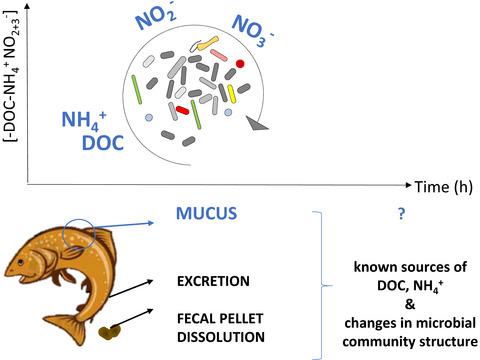当前位置:
X-MOL 学术
›
Microbiologyopen
›
论文详情
Our official English website, www.x-mol.net, welcomes your
feedback! (Note: you will need to create a separate account there.)
Bacterioplankton response to nitrogen and dissolved organic matter produced from salmon mucus
MicrobiologyOpen ( IF 3.9 ) Pub Date : 2020-11-24 , DOI: 10.1002/mbo3.1132 Verónica Molina 1, 2 , Camila Fernández 3, 4, 5, 6
MicrobiologyOpen ( IF 3.9 ) Pub Date : 2020-11-24 , DOI: 10.1002/mbo3.1132 Verónica Molina 1, 2 , Camila Fernández 3, 4, 5, 6
Affiliation

|
Aquaculture releases organic matter to the water column through excretion, fecal pellets, and uneaten food, but also by the continuous release of fish epithelium mucus. The effect of the latter on natural bacterial assemblages was determined using ammonium amended experiments at Puyuhuapi fjord in Chilean Patagonia. Mucus was added to seawater coming from 2 and 100 m depth and ammonium, nitrite and nitrate, dissolved organic carbon (DOC), picoplankton abundance, and active composition (i‐tag 16S rRNA) were followed for 24 h. The results showed a significant response from the microbial community but only at surface depth after 2 and 6 h of incubation. A reduction of DOC and ammonium concentration and accumulation of nitrite and nitrate over time was observed, mainly at 100 m. Changes in the composition of active bacteria between treatments were observed at different taxonomic levels, associated with Alphaproteobacteria (Clade SAR11), Bacteroidetes (Polaribacter) and Gammaproteobacteria (Colwellia, Oceaniserpentilla) and other bacteria such as Nitrospina sp, a nitrite‐oxidizing bacteria at some hours during the incubation. Fish pathogens, such as Vibrio and Piscirickettsia were rare (<0.02%). Overall, our study suggests that fish mucus can cause rapid modifications in microbial assemblages and stimulate organic matter and nutrient cycling, including heterotrophic and autotrophic (nitrification) in areas influenced by aquaculture.
中文翻译:

浮游细菌对鲑鱼粘液产生的氮和溶解有机物的反应
水产养殖通过排泄物、粪便颗粒和未食用的食物,以及鱼上皮粘液的持续释放,将有机物释放到水体中。后者对天然细菌组合的影响是在智利巴塔哥尼亚的 Puyuhuapi 峡湾使用铵修正实验确定的。将粘液添加到来自 2 和 100 m 深度的海水中,并跟踪铵、亚硝酸盐和硝酸盐、溶解有机碳 (DOC)、微型浮游生物丰度和活性成分 (i-tag 16S rRNA) 24 小时。结果显示微生物群落的显着响应,但仅在孵育 2 和 6 小时后在表面深度。随着时间的推移,观察到 DOC 和铵浓度的降低以及亚硝酸盐和硝酸盐的积累,主要是在 100 m 处。Polaribacter)和γ-变形菌(Colwellia,Oceaniserpentilla)和其他细菌如Nitrospina SP,亚硝酸氧化细菌在培养期间的某一小时。鱼类病原体,如弧菌和Piscirickettsia很少见 (<0.02%)。总体而言,我们的研究表明,鱼类粘液可以导致微生物群落的快速改变,并刺激有机物质和营养循环,包括受水产养殖影响的地区的异养和自养(硝化)。
更新日期:2020-12-23
中文翻译:

浮游细菌对鲑鱼粘液产生的氮和溶解有机物的反应
水产养殖通过排泄物、粪便颗粒和未食用的食物,以及鱼上皮粘液的持续释放,将有机物释放到水体中。后者对天然细菌组合的影响是在智利巴塔哥尼亚的 Puyuhuapi 峡湾使用铵修正实验确定的。将粘液添加到来自 2 和 100 m 深度的海水中,并跟踪铵、亚硝酸盐和硝酸盐、溶解有机碳 (DOC)、微型浮游生物丰度和活性成分 (i-tag 16S rRNA) 24 小时。结果显示微生物群落的显着响应,但仅在孵育 2 和 6 小时后在表面深度。随着时间的推移,观察到 DOC 和铵浓度的降低以及亚硝酸盐和硝酸盐的积累,主要是在 100 m 处。Polaribacter)和γ-变形菌(Colwellia,Oceaniserpentilla)和其他细菌如Nitrospina SP,亚硝酸氧化细菌在培养期间的某一小时。鱼类病原体,如弧菌和Piscirickettsia很少见 (<0.02%)。总体而言,我们的研究表明,鱼类粘液可以导致微生物群落的快速改变,并刺激有机物质和营养循环,包括受水产养殖影响的地区的异养和自养(硝化)。











































 京公网安备 11010802027423号
京公网安备 11010802027423号